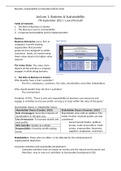Business, Sustainability & Innovation (GEO3-2122)
Lecture 1: Business & Sustainability
7th September 2021 | Laura Piscicelli
Table of Contents
1. The Role of Business in Society
2. The Business Case for Sustainability
3. Corporate Sustainability and its Implementation
Business
Business Enterprise (a.k.a. firm or
company): A profit-seeking
organization that provides
goods/services designed to satisfy
customers’ needs, by transforming
lower-value inputs into higher-value
outputs.
The Value Chain: The value chain
depicts all the activities a company
engages in while doing business.
1. The Role of Business in Society
Who benefits from a firm’s activities?
- The firm, employees, customers, the state, shareholders and other stakeholders.
Who should benefit from the firm’s activities?
- The environment
Friedman (1970): “There is only one responsibility of business: use resources and
engage in activities to increase profits as long as it stays within the rules of the game.”
Shareholder theory vs Stakeholder theory
Shareholder theory (Castelo, 2013) Stakeholder theory (Freeman, 2015)
Role of managers: Serve the interests of Shareholder view with an addition: The
shareholders in the best way. needs of other involved parties are also
Use of resources: To increase wealth and considered:
seek profits. - Governmental bodies, political
Who benefits: Society as a whole groups, trade associations, trade
Responsibility: Economic profit-making unions, communities, financiers,
terms suppliers, employees, customers.
Stakeholders: Those who can affect, or be affected by, the achievement of
organizational objectives.
Corporate activities and sustainable development
- Corporate activities have an impact on society and the natural environment and,
therefore, may or may not contribute to Sustainable Development (SD).
,Business, Sustainability & Innovation (GEO3-2122)
- Stakeholders’ expectations about the environment can affect business:
o Threats: e.g. rejection of environmentally harmful products.
o Opportunities: Preference for environmentally friendly goods (e.g. new
market opportunity, investments).
2. The Business Case for Sustainability
Business Case: Whether and how a company can actively create synergies between
managing environmental or social issues in a way that increases corporate economic
performances.
1. Costs and costs reduction (cost savings)
2. Risk and risk reduction (improving risk management)
3. Sales and profit margin
4. Reputation and brand value
5. Attractiveness as an employer (employee motivation)
6. Innovative capabilities (fostering innovation)
3. Corporate sustainability and its implementation
What does a company do to become more sustainable?
Examples:
- Labels for certified products
- Sustainability management systems and standards for organizations
- Involvement in multi-stakeholder initiatives
- (Eco-)innovations: new or better products, processes, marketing methods or
organizational methods.
The Sustainability Triangle
Five Stages of Organizational Growth
1. Defensive stage: “It’s not our job to fix that.”
2. Compliance stage: “We’ll do just as much as we have to do.”
3. Managerial stage: “It’s the business, stupid.”
4. Strategic stage: “It gives us a competitive edge.”
5. Civil stage: “We need to make sure everybody does it.”
, Business, Sustainability & Innovation (GEO3-2122)
Lecture 2: Organizational Innovations
14th September 2021 | Laura Piscicelli
Table of Contents
1. Business models
1.1. The business model canvas
1.2. Business model categories
1.3. Business models and strategy
2. Business Model Innovation
2.1. BMI for Sustainability
2.2. Sustainable Business Models
2.3. Circular Economy Business Model (CEBM) Patterns
3. Appendix 1: Value Proposition Canvas
1. Business models (BMs)
Business Models: Stories that explain how enterprises work.
- BM is a conceptual tool to help understand how a firm does business.
- A Business Model describes the rationale of how an organization creates, delivers,
and captures value.
1.1 The Business Model Canvas (BMC)
The Busines Model Canvas: A tool for describing, analyzing, and designing Business Models.
- The BMC has 9 building blocks.
- Value Creation is described on the left side, Value Delivery & Capture on the right
side.
Value Creation Value Delivery & Capture




